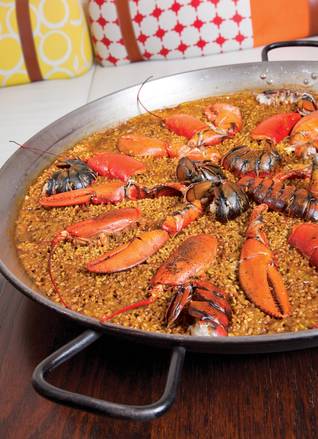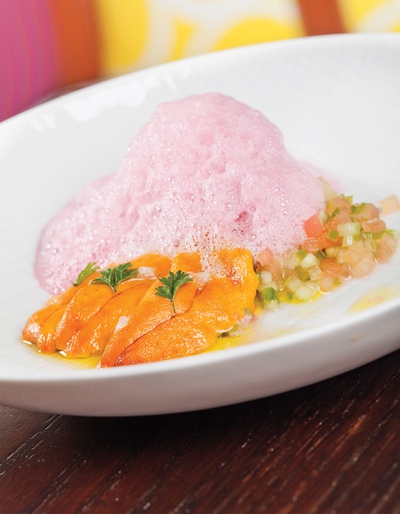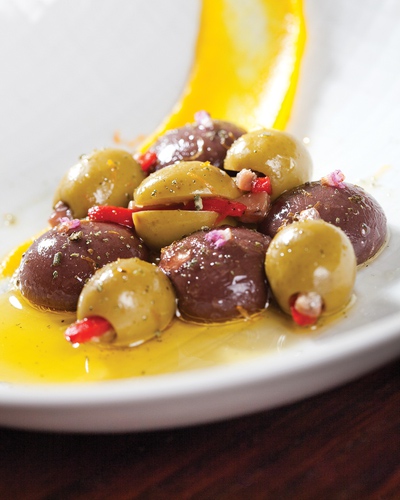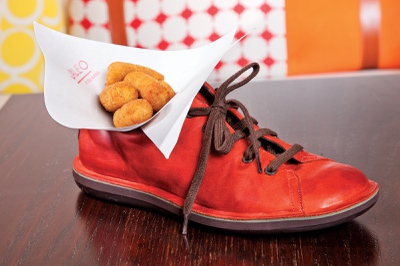Wednesday, March 2, 2011 | 5:49 p.m.
One need look no further than the crowds at Jaleo in the Cosmopolitan any night of the week to see that this casual, small-plates, share-and-share-alike restaurant has captured the zeitgeist of how people are eating out these days. Traditional three-course meals might still have their place, but communal dining, Spanish-style, is about as hot as it gets, and no chef is hotter that José Andrés. Which means no restaurant in Vegas is busier right now than Jaleo.
Andrés’ rise to such prominence was hardly meteoric. He opened the first Jaleo in Washington, D.C., in 1993, but it wasn’t until 2008 that his (and Spain’s) culinary fortunes took off. With the premier of his PBS food show, Made in Spain, early that year, followed by the opening of the Bazaar in Los Angeles to rave reviews, Andrés assumed the mantle of Chef of the Moment, and Spain was suddenly the next big thing in the food world. Enticing him to plant his flag in Vegas was as important for Cosmo as bringing in Le Cirque was to the Bellagio in 1998. And now that Andrés is here, a spin around his menu is about as close to a trip to Barcelona as you can get without stamping your passport.
Restaurant Guide
- Jaleo
- At the Cosmopolitan, 877-551-7772.
- Sunday-Thursday, 5-11 p.m.; Friday-Saturday, 5 p.m.-midnight.
The cuisine of Spain—like that of Italy and Japan—is ingredient-driven. China and France (the other two great cuisines of the world) are structured according to their highly refined cooking techniques, as much as by the purity of their raw ingredients. Spanish chefs look to the bounty of the Mediterranean for some of the best seafood on Earth, as well as everything from piquillo peppers to Ibérico ham—ingredients to display and eat, with as little human intervention as possible. It is a testament to the genius of Andrés that he’s able to construct a menu that moves easily from pristine raw ingredients (fried organic egg with caviar) to the deceptively simple (datiles con tocino—fried dates wrapped in bacon) to the baffling (liquid olives ‘Ferrán Adria’) to the complex (fresh sea urchin with diced peppers, tomatoes and pomegranate air), while keeping diners blissfully off-balance and entertained the entire time.
The best way to enjoy the wacky Spanish vibe of Jaleo is to dive in and hold on. Like a traditional tapas restaurant, the joy comes from the blizzard of small plates that will appear at your table, each one seemingly more wonderful than the last. The three-page menu lists nearly 70 items, and you can study and stew over it (a big mistake) or just point and pick. No matter what else you eventually decide on, those molecular olives are a must, formed by dropping olive purée into an alginate bath that causes the purée to thicken and a clear edible shell to form around it. Another good (and familiar) starter is the brightest, most intense gazpacho you will ever encounter. From there, head to “José’s Way” on the menu—first for a single, fried organic egg topped with caviar (resembling a deep-fried/poached egg), then for six oysters with lemon, gin and tonic, a marvel of a “Why didn’t I think of that?” composition. More adventuresome palates will gasp over the small sea urchins covered with pomegranate air (foam), and how the fruit’s tartness cuts through the guttural brininess of the uni. Those looking for more traditional fare will find it in the thick napping of king crab and potatoes with garlicky mayonnaise, or the fried croquetas de pollo (deep-fried nuggets containing chicken in a Béchamel sauce). Even something as simple-sounding as a warm Brussels sprouts salad will have you scratching your head over how a jumble of tiny cabbages tossed with apples, apricots and slivers of ham can be so toothsome.
About the only thing on the menu I’m not crazy about is the Canary Island-style rabbit confit, not because it isn’t tasty but because the tiny structure (and bones) of the silly wabbit makes it difficult to eat. A better choice for the table will always be whatever paella they’re cooking that night in the spectacular paella pit. This giant rotunda of flame holds one to four high heat, all wood fires every night—each one imparting a smoky intensity to the rice and its adjuncts as they simmer in huge, shallow circular pans. Andrés claims no other Spanish restaurant in America has gone to the trouble or expense to bring such Valencian authenticity to this national dish, and I have no reason to doubt him. After one taste of any of his paellas, you will have no reason to order it anywhere else, either.
Learn to speak Jaleo
Paella (PIE-ay-ya) The Valencian rice dish, studded with everything from rabbit to runner beans, cooked in wide, shallow, circular pans, ideally over an open fire.
Jamón Ibérico (HAH-mon EE-bare-ee-co) Cured pork product known the world over for its affinity for cheese, but reaching its apotheosis with the legs of the black footed pata negra pigs of Southern Spain.
Albariño (All-ba-REEN-yo) A variety of white-wine grape, grown in Northwest Spain, that makes outstanding, acidic, perfume-y, well-priced whites that will have you wondering what you ever saw in chardonnay.
Croquetas (cro-KET-as) Any manner of fried-food roll made by cuisines the world over, but, once again, reaching an alimentary apex with the Spanish method of combining diced ham or chicken in a thick, rich Béchamel sauce before deep-frying.





Join the Discussion:
Check this out for a full explanation of our conversion to the LiveFyre commenting system and instructions on how to sign up for an account.
Full comments policy